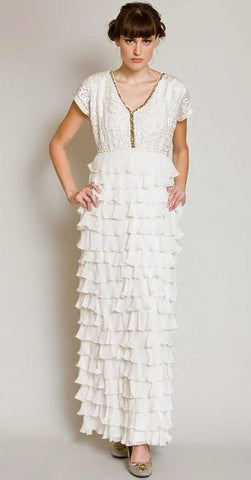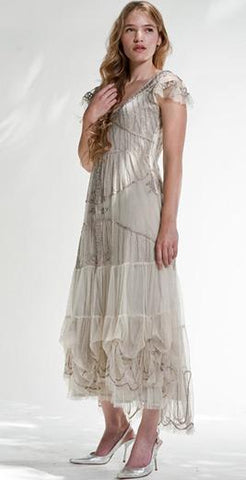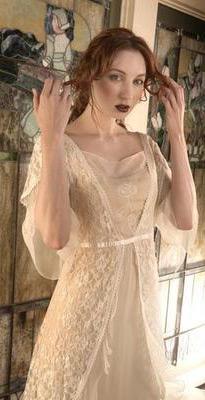The New Tendencies of the Past-Victorian Period
by Karen
The mid-19th century was a real milestone in the history of fashion. These years transformed fashion as trend into the fashion industry. The first adapted sewing machines were invented, and the first workable colorants were applied to different types of fabrics, facilitating the production of more and higher quality fabrics. These fabrics, in turn, had a great influence on the range of fashion trends. The first true haute couture fashion appeared during the period. From that moment on, the fashion trends were no longer the static forms and silhouettes that had been popular for decades, but they became really dynamic and creative.
The first changes appeared in the early 1870s. The days of crinoline full skirts were gone, and longer whimsical forms of skirts à la Anna Karenina finally appeared. To us, bustle skirt form seems really bizarre, reminding us of walking geese, but during those days, the form was the latest in fashion. As a result, the ladies of the late 1870s could hardly remind their predecessors of the early 1860s. The massive forms were gone, letting designers invent new forms. Designers had to invent new styles of dress that took into account the figures of their customer. They had to make beautiful swans of (sometimes) truly ugly ducklings. The late Victorian period is oftentimes referred to as the late 1870s–1900s. The post-Victorian period, in turn, is the period between the early 1900s and 1920 — right up until the beginning of the roaring twenties. Yet some of the stylists and designers claim it is not so. If we remember the full skirts of the early 1960s worn by Audrey Hepburn, we may confess that some skirt lines really looked like Victorian-inspired silhouettes. Even the 1970s-inspired boho gowns sometimes recalled the non-corset bohemian gowns of the late 19th century. Today, Victorian-inspired fashion is twisting and spiraling. New fashion designers do not deny that they draw their inspiration from pictures of the late Victorian era or post-Victorian epochs. All romantic dresses are the descendants of Victorian gowns. La Belle Époque (1900–1915s) was really the perfect period of cultural technical development. Changes in the world economy and in Western civilization allowed many people have money and possibilities. The golden age of the Victorian epoch was highbrow, whereas the Edwardian (post-Victorian) generation started taking into account the changes in culture, including the styles of dress. Many people of La Belle Époque believed the styles of Paris were completely tasteless. But to us, the style of La Belle Époque is really romantic and eclectic. The makeup of La Belle Époque influenced the style of makeup until the late 1920s. So we may confess that the post-Victorian fashion (as well as Victorian fashion) is reborn over and over again! All neo-Victorian and post-Victorian fashions can be recognized easily. The romantic style is the style of laces, fitting gowns and pastel colors. Such gowns can also be referred to as neo-Edwardian gowns. The Victorian gothic and Victorian classic can be seen in dresses with high collars and puffy/leg-of-mutton sleeves. In their day, Ralph Lauren, Alexander McQueen and Tommy Hilfiger presented these styles in their runways shows. Also, the waist line of post-Victorian fashion silhouettes is probably one of the key accents in these silhouettes overall. Sometimes, Viktor & Rolf demonstrate the same fashions during runway shows. The early period of Victorian fashion was famous for saturated colors, and the apparel was very bright and pretty. The inspiration in the early days of Victorian fashion was all about Christian Lacroix and Vivienne Westwood. But oftentimes, post-Victorian and neo-Victorian fashion is considered soft, mild, steady, pastel and full of airy fabrics. The fabulous fashion designer Nataya loves to show off the romance of the post-Victorian era. We have selected only the 7 best-selling gowns styled as Edwardian or neo-Victorian silhouettes, but you may find the new favorites in our catalogue. Do not forget to check the new spring collection by Nataya either. • The Winter Artisan Dress, as any dress of the early Victorian epoch, is full of saturated colors. It is also a perfect evening set for the gals who prefer Victorian informality. • The Nataya Vintage Wedding Dress is another perfect sample of post-Victorian fashion. This gown with dizzy frills makes any silhouette slimmer.
• The Nataya Vintage Wedding Dress is another perfect sample of post-Victorian fashion. This gown with dizzy frills makes any silhouette slimmer.
 • The Titanic-Inspired Dress in sage demonstrates the post-Victorian classic look.
• The Titanic-Inspired Dress in sage demonstrates the post-Victorian classic look.
 • The Tulle Wedding Dress in Sage will definitely remind you of Alice’s Adventures in Wonderland and the last days of Victoria’s empire.
• The Tulle Wedding Dress in Sage will definitely remind you of Alice’s Adventures in Wonderland and the last days of Victoria’s empire.
 • Additionally, we cannot help but mention the best-selling Edwardian Dress in lace, which is about to go on sale to the public. So if you draw your inspiration from post-Victorian romance, you should hurry, as the model will soon be available no longer.
• Additionally, we cannot help but mention the best-selling Edwardian Dress in lace, which is about to go on sale to the public. So if you draw your inspiration from post-Victorian romance, you should hurry, as the model will soon be available no longer.
 Whatever the style of your occasion, we are glad to present the top sellers from the Collection by Nataya. Find your preferred post-Victorian romance style, and please, don’t forget to share your happy experiences.
Whatever the style of your occasion, we are glad to present the top sellers from the Collection by Nataya. Find your preferred post-Victorian romance style, and please, don’t forget to share your happy experiences.
The first changes appeared in the early 1870s. The days of crinoline full skirts were gone, and longer whimsical forms of skirts à la Anna Karenina finally appeared. To us, bustle skirt form seems really bizarre, reminding us of walking geese, but during those days, the form was the latest in fashion. As a result, the ladies of the late 1870s could hardly remind their predecessors of the early 1860s. The massive forms were gone, letting designers invent new forms. Designers had to invent new styles of dress that took into account the figures of their customer. They had to make beautiful swans of (sometimes) truly ugly ducklings. The late Victorian period is oftentimes referred to as the late 1870s–1900s. The post-Victorian period, in turn, is the period between the early 1900s and 1920 — right up until the beginning of the roaring twenties. Yet some of the stylists and designers claim it is not so. If we remember the full skirts of the early 1960s worn by Audrey Hepburn, we may confess that some skirt lines really looked like Victorian-inspired silhouettes. Even the 1970s-inspired boho gowns sometimes recalled the non-corset bohemian gowns of the late 19th century. Today, Victorian-inspired fashion is twisting and spiraling. New fashion designers do not deny that they draw their inspiration from pictures of the late Victorian era or post-Victorian epochs. All romantic dresses are the descendants of Victorian gowns. La Belle Époque (1900–1915s) was really the perfect period of cultural technical development. Changes in the world economy and in Western civilization allowed many people have money and possibilities. The golden age of the Victorian epoch was highbrow, whereas the Edwardian (post-Victorian) generation started taking into account the changes in culture, including the styles of dress. Many people of La Belle Époque believed the styles of Paris were completely tasteless. But to us, the style of La Belle Époque is really romantic and eclectic. The makeup of La Belle Époque influenced the style of makeup until the late 1920s. So we may confess that the post-Victorian fashion (as well as Victorian fashion) is reborn over and over again! All neo-Victorian and post-Victorian fashions can be recognized easily. The romantic style is the style of laces, fitting gowns and pastel colors. Such gowns can also be referred to as neo-Edwardian gowns. The Victorian gothic and Victorian classic can be seen in dresses with high collars and puffy/leg-of-mutton sleeves. In their day, Ralph Lauren, Alexander McQueen and Tommy Hilfiger presented these styles in their runways shows. Also, the waist line of post-Victorian fashion silhouettes is probably one of the key accents in these silhouettes overall. Sometimes, Viktor & Rolf demonstrate the same fashions during runway shows. The early period of Victorian fashion was famous for saturated colors, and the apparel was very bright and pretty. The inspiration in the early days of Victorian fashion was all about Christian Lacroix and Vivienne Westwood. But oftentimes, post-Victorian and neo-Victorian fashion is considered soft, mild, steady, pastel and full of airy fabrics. The fabulous fashion designer Nataya loves to show off the romance of the post-Victorian era. We have selected only the 7 best-selling gowns styled as Edwardian or neo-Victorian silhouettes, but you may find the new favorites in our catalogue. Do not forget to check the new spring collection by Nataya either. • The Winter Artisan Dress, as any dress of the early Victorian epoch, is full of saturated colors. It is also a perfect evening set for the gals who prefer Victorian informality.


• The Post-Victorian Dress in black is a godsend for all brides looking for alternative, gothic-inspired gowns.
• If you are looking for the colors of the late Victorian epoch, the Victorian Chiffon Outfit in violet is one of the “must haves.”















Leave a comment